Mastering Olive Tree Care: Essential Tips for Healthy Trees
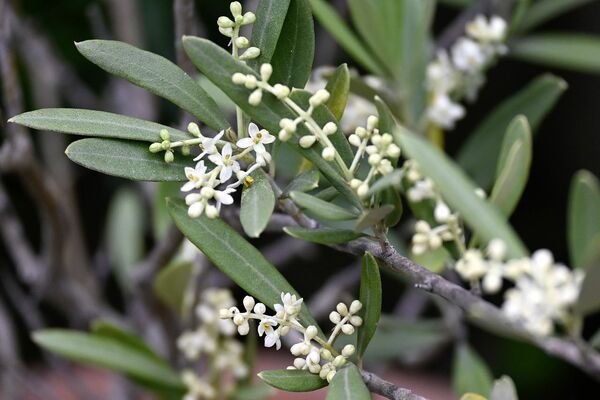
Image by Stefan Niess from Pixabay
Introduction
Olive trees are popular for a number of reasons. Their historic significance, attractive aesthetic appeal, their natural pest resistance, and the ease of tending to them make olive trees an excellent choice for many tree and plant lovers. While they originate from the warm region of the Mediterranean, when you understand how to care for olive trees, they can be grown almost anywhere. They tend to thrive as long as they get ample light and water and are properly cared for with the right soil conditions, fertilizers, and pruning as needed. Here, we’ll discuss the basics of growing olive trees and proper upkeep methods.
The Basics of the Olive Tree Care Process
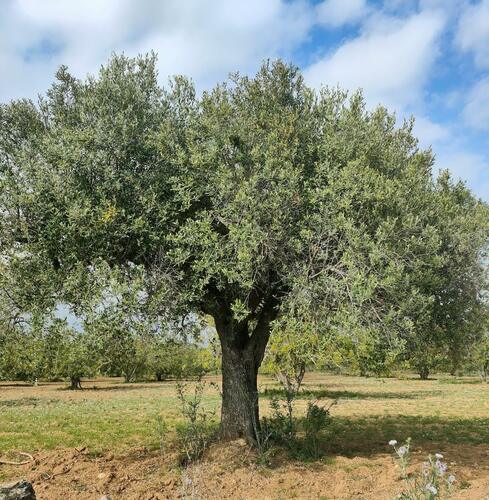
A Mature Olive Tree - Photo by Esencia de Plantas on Unsplash
Growing olive trees is possible both indoors and outdoors as long as it gets ample sunlight. Those who live in Zones 8 to 11 see good results when the tree is planted outside where it gets 4 to 8 hours of direct sun. Many choose pot up their trees, which makes it easy to bring them indoors should temperatures drop.
If you opt for growing olive trees in the ground, dig a hole sizable enough to accommodate the root ball of the tree. After placing the tree in the hole, fill it up with soil and tamp it down to secure it. Give it a bit of water to settle the roots. It’s good to add some mulch around the base to conserve moisture and reduce weed growth. Be sure to keep the mulch a few inches away from the trunk of the tree.
For growing indoors, the process is fairly straightforward. Choose a pot that’s around one-and-a-half to two times the size of its original purchased container. All you need for a thriving olive tree is a sunny window that gets plenty of sunlight, preferably a south-facing one. The best soil for olive trees is the same whether you grow it in a pot or in the ground. Choose a soil that’s moderately acidic or alkaline. Ideally, use a mixture that has a pH between 8 and 8.5, and to increase the pH, use a soil with lime, or lower it using a sulfur supplement. Adequate drainage is essential, and using a loam-based compost and 20% grit can improve drainage substantially.
How to Care for Olive Trees Year-Round
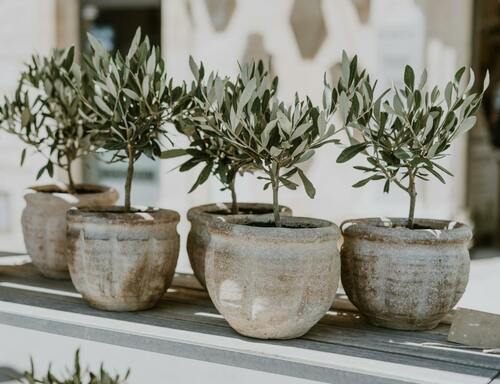
Small Potted Olive Trees - Photo by Anita Austvika on Unsplash
You’ve planted your olive tree, and now it’s time to be prepared for its upkeep. Here are some olive tree maintenance tips to ensure you have a thriving plant for years to come.
Watering should be done on a routine schedule, and typically, one or two waterings every week is sufficient. If you’re not sure when it’s time to water, use a finger to check that it has adequate moisture in the top two inches. These conditions will fluctuate depending on rain levels and other weather during the year. Container-planted trees have the same rule of thumb concerning moisture. Be sure to add
water to pots until you see some draining from the bottom.
Fertilizing Olive Trees
It’s not necessary to fertilize these trees, but you’re more likely to have a bigger harvest if you do. We recommend fertilizing them biannually using a high-nitrogen, slow-release formula. Using a premium, slow-release fertilizer rich with essential minor elements like calcium, zinc, and boron during growth-intensive seasons enriches the soil. You can add a bit of this mixture every few weeks to promote growth and to enhance the trees' resistance to pests and diseases.
Pruning Olive Trees
Routine and maintenance pruning means observing the tree, especially during picking time. The fruit hails from the lateral and hanging branches rather than the verticals. Some of its hanging branches that have produced fruit in the early years may become weak and exhausted. Cut those off to increase the health and production capacity of the tree. Again, when picking, it’s easy to get a close look at its overall condition and what pruning should be done.
Mulching and Root Protection
Proper mulching is pivotal for soil moisture retention and to help regulate the roots’ temperature. The best mulch is pine straw, as wood chips and options with a high carbon content can cause the soil’s nitrogen to deplete during decomposition. Apply mulch that allows a bit of clearance from the trunk to prevent potential rotting and excessive moisture.
Pest, Weed, and Disease Control
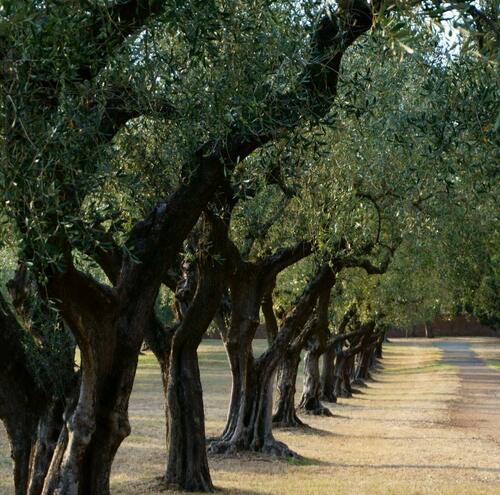
A Row of Olive Trees - Photo by Kevin Martin Jose on Unsplash
Growing olive trees can require prevention and control methods for certain pests, diseases and weeds.
Insects
Armored-scale insects can infest the trees and often can be seen as a sooty mold on the bark and leaves, and there may be excessive crawling ants on the tree. Early detection and quick intervention are critical to prevent extensive damage and to manage infestations. Trees planted near other pest-attracting trees or plants can be inviting for stink bugs and thrips.
Weeds
In climates with mild temperatures and moist leaves, frequently due to high humidity, weeds can flourish, and young olive trees tend to be more prone to weeds. Ground weeds can spread fungi to the leaves, infecting them. Treatment first involves removing the invaders and applying mild herbicides. Treatments using copper salts are the most effective at preventing and helping kill the weeds.
Reptilo (Leaf Spots)
This fungal disease attacks the tree’s leaves and minimizes its ability to grow and have fruitful harvests. The best line of defense is to avoid cultivating it in climates that are known to harbor this disease.
Tuberculosis (Pseudomonas savastonoi)
This bacterium creates small tumors on branches and can infect the tree quickly. Again, the only curative treatment is copper salt to stop new tumors from invading the tree.
Anthracnose and Olive Leprosy
Leprosy is highly aggressive in cold winter weather, and trees with very dense crowns result in tree damage that can be severe. Younger trees are more at risk for these common disease infestations. Using copper by early summer along with early harvesting offers prevention when the colder weather arrives. You might consider pruning branches for lower crown density, as curative treatments of any kind are not effective as treatment.
Seasonal Care for Healthy Olive Trees
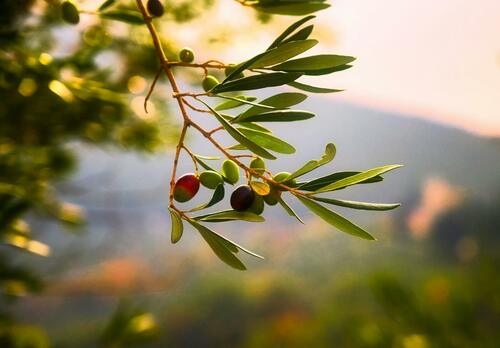
A Fruit-Bearing Olive Branch - Photo by Lucio Patone on Unsplash
When properly cared for routinely, olive trees can grow larger and offer more production. Pruning trees isn’t necessary for the first two years of their life. Remove any dying or sick branches and any yellow or dead leaves during the fall and winter seasons.
Fertilize the plants twice a month in summer and spring with a slow-release balanced fertilizer. After fertilizing, trees may require more frequent watering. To keep pests and insects at bay, inspect for any signs of them to begin the eradication and prevention processes. Those who want organic pest and weed control can introduce neem oil to the soil.
FAQs
Are olive trees relatively easy to grow?
Yes, olive trees are typically easy to grow with recommended upkeep. You’ll want to water them regularly while they’re getting established.
Can olive trees grow in colder climates?
In frigid weather conditions, bring in any olive trees you placed in pots to keep them protected from frost. In-ground winter care requires wrapping the trunk with pine straw or a special antifreeze cover.
What is the average lifespan of an olive tree?
Olive trees can live for up to one hundred years with proper planting, pruning, fertilization, and watering routines.
Plant Olive Trees for Beauty and Fruit
Along with its historical significance and the various uses for the fruit it grows, having an olive tree makes a wonderful addition to your landscape or indoor space. While they are low-maintenance, having them tended to on a regular schedule takes a bit of time and effort. Using the tips provided here, you can expect a successful olive tree for years to come. For more advice on growing plants and trees, sign up for our gardening newsletter and follow us on social media.





